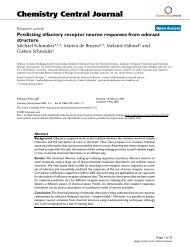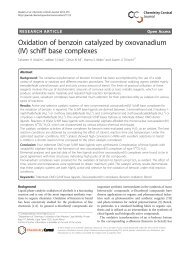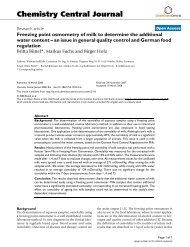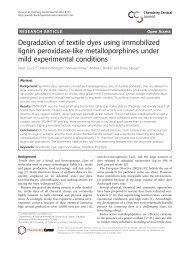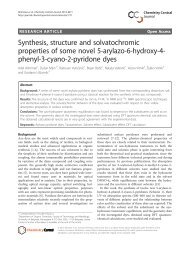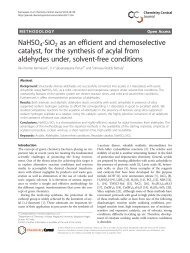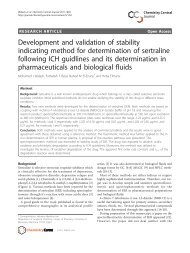Quinazoline derivatives: synthesis and bioactivities - Chemistry ...
Quinazoline derivatives: synthesis and bioactivities - Chemistry ...
Quinazoline derivatives: synthesis and bioactivities - Chemistry ...
Create successful ePaper yourself
Turn your PDF publications into a flip-book with our unique Google optimized e-Paper software.
Wang <strong>and</strong> Gao <strong>Chemistry</strong> Central Journal 2013, 7:95 Page 12 of 15<br />
http://journal.chemistrycentral.com/content/7/1/95<br />
bacterium (Salmonella typhimurium, Escherichia coli <strong>and</strong><br />
Klebsiella pneumonia), <strong>and</strong> pathogenic fungus (Aspergillus<br />
niger, C<strong>and</strong>ida albicans <strong>and</strong> Trichoderma viridae) asthe<br />
test bacterium, <strong>and</strong> st<strong>and</strong>ard drug ampicillin <strong>and</strong> ketoconazole<br />
as reference, which indicated that some of the synthesized<br />
compounds showed favorable inhibition against<br />
the tested microorganism [7].<br />
2,4,6-trisubstituted quinazolines Ch<strong>and</strong>rika et al. synthesized<br />
<strong>and</strong> biologically evaluated various 2,4,6-trisubstituted<br />
quinazoline <strong>derivatives</strong>. The core of compound 98 (Figure 4)<br />
showed antimicrobial activities against gram-positive bacterium<br />
<strong>and</strong> gram-negative bacterium. In addition, it could<br />
be drawn from the SAR that decylamine group substituted<br />
at C-4 is beneficial to the activity while iodo-group at C-6<br />
is detrimental to activity [12].<br />
Conclusions<br />
Traditional synthetic methods for quinazoline <strong>derivatives</strong>,<br />
still in general use, including Aza-synthetic method,<br />
refluxing, oxidative cyclization, are fundamental methods<br />
for the <strong>synthesis</strong> of this important heterocyclic compounds.<br />
It could be seen from the examples compiled<br />
above that some novel synthetic methods are in constant<br />
development, <strong>and</strong> different methods are adopted in the<br />
<strong>synthesis</strong> of different quinazoline analogues, such as<br />
phase-transfer <strong>synthesis</strong>, ultrasound-promoted <strong>synthesis</strong>,<br />
etc. The gradually improved synthetic methods better<br />
the synthetic research on quinazoline <strong>derivatives</strong><br />
withatendencyoffaster,morediverse<strong>and</strong>moreconvenient.<br />
Then, for another, it is known that substituents<br />
at different positions affect the activity differently. For<br />
instance, quinazoline <strong>derivatives</strong> with imidazole substituted<br />
at the 2-position of side chain own potent antiinflammatory<br />
function; <strong>and</strong> quinazoline <strong>derivatives</strong> with<br />
amine or substituted amine on 4-position <strong>and</strong> either<br />
halogens or electron rich substituent groups on 6-<br />
position could promote the anti-cancer <strong>and</strong> antimicrobial<br />
activities [7,12], etc. By careful observation of<br />
the recent researches, 2-, 4- <strong>and</strong> 6-position substituted<br />
quinazoline analogs remain majority among the products.<br />
However, with the deepening <strong>and</strong> development of<br />
researches, substituent groups at other positions are<br />
also achieved <strong>and</strong> studied increasingly, such as the construction<br />
of N-heterocyclic quinazolines by introduction<br />
of active groups into 3-position of quinazoline core. It is<br />
worth mentioning that N-heterocyclic quinazolines<br />
with more rigid <strong>and</strong> complicated structure were synthesized<br />
successively, some of which showed excellent<br />
antimicrobial properties. In addition, it could be drawn<br />
from the research progress above that enhancement of<br />
activity by splicing method of installing various active<br />
groups is <strong>and</strong> will still be the main method for drug<br />
design <strong>and</strong> reconstruction of quinazoline <strong>derivatives</strong>.<br />
Competing interests<br />
The authors declare that they have no competing interests.<br />
Authors’ contributions<br />
FG <strong>and</strong> DW have been involved in preparing the manuscript. The two<br />
authors are thought to have equal contributions. Both authors have read<br />
<strong>and</strong> approved the final manuscript.<br />
Acknowledgement<br />
This project was supported by the National Natural Science Foundation of<br />
China (No. 81001383) <strong>and</strong> the Doctoral Foundation of Ministry of Education<br />
of China (No. 20105103120009).<br />
Received: 22 February 2013 Accepted: 26 April 2013<br />
Published: 3 June 2013<br />
References<br />
1. Ch<strong>and</strong>regowda V, Kush AK, Ch<strong>and</strong>rasekara Reddy G: Synthesis <strong>and</strong> in vitro<br />
antitumor activities of novel 4-anilinoquinazoline <strong>derivatives</strong>. Eur J Med<br />
Chem 2009, 44:3046–3055.<br />
2. Al-Rashood ST, Aboldahab IA, Nagi MN, Abouzeid LA, Abdel-Aziz AA,<br />
Abdel-Hamide SG, Youssef KM, Al-Obaid AM, El-Subbagh HI: Synthesis,<br />
dihydrofolate reductase inhibition, antitumor testing, <strong>and</strong> molecular<br />
modeling study of some new 4(3H)-quinazolinone analogs. Bioorg Med<br />
Chem 2006, 14:8608–8621.<br />
3. Vasdev N, Dorff PN, Gibbs AR, N<strong>and</strong>anan E, Reid LM, Neil JPO’, VanBrocklin HF:<br />
Synthesis of 6-acrylamido-4-(2-[18F] fluoroanilino) quinazoline: A<br />
prospective irreversible EGFR binding probe. J Lablelled Compd Rad 2005,<br />
48:109–115.<br />
4. Wakeling AE, Guy SP, Woodburn JR, Ashton SE, Curry BJ, Barker AJ, Gibson KH:<br />
ZD1839 (Iressa): an orally active inhibitor of epidermal growth factor<br />
signaling with potential for cancer therapy. Cancer Res 2002, 62:5749–5754.<br />
5. Alagarsamy V, Solomon VR, Dhanabal K: Synthesis <strong>and</strong> pharmacological<br />
evaluation of some 3-phenyl-2-substituted-3H -quinazolin-4-one as<br />
analgesic, anti-inflammatory agents. Bioorg Med Chem 2007, 15:235–241.<br />
6. Baba A, Kawamura N, Makino H, Ohta Y, Taketomi S, Sohda T: Studies on<br />
disease-modifying antirheumatic drugs: <strong>synthesis</strong> of novel quinoline <strong>and</strong><br />
quinazoline <strong>derivatives</strong> <strong>and</strong> their anti-inflammatory effect1. J Med Chem<br />
1996, 39:5176–5182.<br />
7. Rohini R, Muralidhar Reddy P, Shanker K, Hu A, Ravinder V: Antimicrobial<br />
study of newly synthesized 6-substituted indolo[1,2-c]quinazolines. Eur J<br />
Med Chem 2010, 45:1200–1205.<br />
8. Antipenko L, Karpenko A, Kovalenko S, Katsev A, Komarovska-Porokhnyavets E,<br />
Novikov V, Chekotilo A: Synthesis of new 2-thio-[1,2,4]triazolo[1,5-c]<br />
quinazoline <strong>derivatives</strong> <strong>and</strong> its antimicrobial activity. Chem Pharm Bull 2009,<br />
57:580–585.<br />
9. Jatav V, Kashaw S, Mishra P: Synthesis <strong>and</strong> antimicrobial activity of some<br />
new 3–[5-(4-substituted)phenyl-1,3,4-oxadiazole-2yl]-2-styrylquinazoline-<br />
4(3H)-ones. Med Chem Res 2008, 17:205–211.<br />
10. Aly AA: Synthesis of novel quinazoline <strong>derivatives</strong> as antimicrobial<br />
agents. Chin J Chem 2003, 21:339–346.<br />
11. Li H, Huang R, Qiu D, Yang Z, Liu X, Ma J, Ma Z: Synthesis <strong>and</strong> bioactivity<br />
of 4-quinazoline oxime ethers. Prog Nat Sci 1998, 8:359–365.<br />
12. Ch<strong>and</strong>rika PM, Yakaiah T, Narsaiah B, Sridhar V, Venugopal G, Rao JV, Kumar KP,<br />
Murthy USN, Rao ARR: Synthesis leading to novel 2,4,6-trisubstituted<br />
quinazoline <strong>derivatives</strong>, their antibacterial <strong>and</strong> cytotoxic activity against<br />
THP-1, HL-60 <strong>and</strong> A375 cell lines. Indian J Chem 2009, 48B:840–847.<br />
13. Paneersalvam P, Raj T, Ishar PS M, Singh B, Sharma V, Rather BA:<br />
Anticonvulsant activity of Schiff bases of 3-amino-6,8-dibromo-2-phenylquinazolin-4(3H)-ones.<br />
Indian J Pharm Sci 2010, 72:375–378.<br />
14. N<strong>and</strong>y P, Vishalakshi MT, Bhat AR: Synthesis <strong>and</strong> antitubercular activity of<br />
Mannich bases of 2-methyl-3H-quinazolin-4-ones. Indian J Heterocycl<br />
Chem 2006, 15:293–294.<br />
15. Saravanan G, Alagarsamy V, Prakash CR: Synthesis <strong>and</strong> evaluation of<br />
antioxidant activities of novel quinazoline <strong>derivatives</strong>. Int J Pharm Pharm<br />
Sci 2010, 2:83–86.<br />
16. Lakhan R, Singh OP, Singh-J RL: Studies on 4 (3H)-quinazolinone<br />
<strong>derivatives</strong> as anti-malarials. J Indian Chem Soc 1987, 64:316–318.<br />
17. Hess HJ, Cronin TH, Scriabine A: Antihypertensive 2-amino-4(3H)-<br />
quinazolinones. J Med Chem 1968, 11:130–136.





